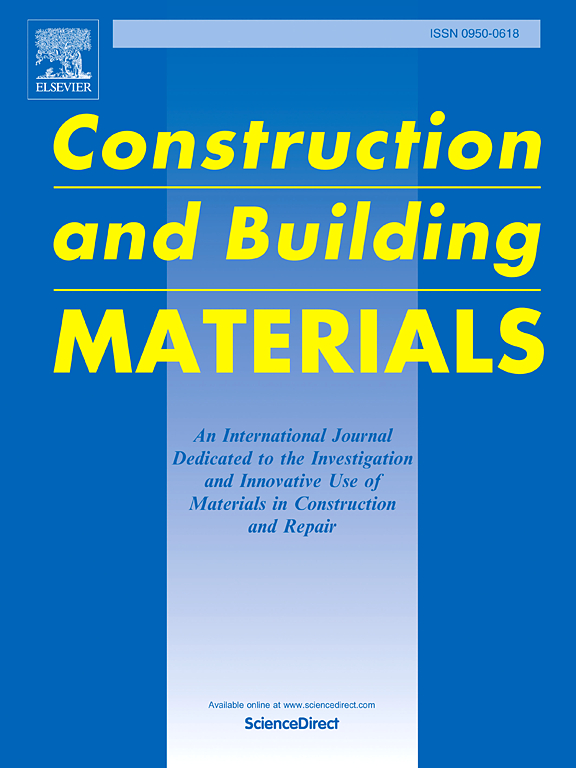Strengthening fire-damaged concrete with jute fiber-reinforced biopolymer: Experimental investigation and sustainability assessment
IF 8
1区 工程技术
Q1 CONSTRUCTION & BUILDING TECHNOLOGY
引用次数: 0
Abstract
Fire-induced damage significantly compromises the structural integrity of concrete, necessitating effective and sustainable repair solutions. This study investigates the effectiveness of jute fiber-reinforced biopolymer (JFRB) composites in restoring the compressive strength of fire-damaged concrete, with a focus on strength performance, predictive modeling, and sustainability. Concrete cylinders with compressive strengths of 35 MPa (S1) and 46 MPa (S2) were exposed to standard fire conditions for 30, 45, and 60 min. Subsequently, the fire-damaged specimens were strengthened with either 1–3 layers of jute fiber-reinforced biopolymer (JFRB) composites or a single layer of carbon fiber-reinforced biopolymer (CFRB) composites. Compression tests were conducted to evaluate the capacity of JFRB and CFRB in restoring the compressive strength of the damaged concrete. The results revealed that JFRB confinement significantly improved residual strength, particularly after 60 min of fire exposure. Strengthening with JFRB composites resulted in compressive strength gains of 2.02–3.69 times for S1 and 1.86–3.67 times for S2, depending on the number of layers applied. Notably, specimens wrapped with three layers of JFRB achieved strength recovery comparable to those reinforced with a single layer of CFRB, highlighting their potential for practical structural rehabilitation applications. Furthermore, an empirical model was developed to predict the compressive strength of both undamaged and fire-damaged concrete confined with JFRB. The model demonstrated superior accuracy compared to existing models, with prediction closely aligning with experimental results (R2=0.83), in estimating the compressive strength of JFRB-confined, fire-damaged concrete. These findings offer a strong experimental foundation and theoretical framework for the integration of JFRB composites into structural engineering practices. A sustainability assessment further highlighted the cost-effectiveness and environmental benefits of JFRB, demonstrating its potential as a practical and eco-friendly material for structural rehabilitation. Therefore, these findings emphasize the dual benefits of using JFRB composites to address both performance recovery and sustainability challenges in fire-damaged structures.
用黄麻纤维增强生物聚合物加固火灾损伤混凝土:实验研究和可持续性评价
火灾引起的损坏严重损害了混凝土的结构完整性,需要有效和可持续的修复方案。本研究探讨了黄麻纤维增强生物聚合物(JFRB)复合材料在恢复火灾损坏混凝土抗压强度方面的有效性,重点研究了强度性能、预测模型和可持续性。抗压强度分别为35 MPa (S1)和46 MPa (S2)的混凝土柱在标准火灾条件下暴露30、45和60 min。随后,用1-3层黄麻纤维增强生物聚合物(JFRB)复合材料或单层碳纤维增强生物聚合物(CFRB)复合材料对火灾损伤的试件进行加固。通过压缩试验,评价了JFRB和CFRB对受损混凝土抗压强度的恢复能力。结果表明,JFRB约束显著提高了残余强度,特别是在60 min的火灾暴露后。使用JFRB复合材料进行强化,根据层数不同,S1的抗压强度增加2.02-3.69倍,S2的抗压强度增加1.86-3.67倍。值得注意的是,用三层JFRB包裹的试件获得的强度恢复与单层CFRB加固的试件相当,这突出了它们在实际结构修复应用中的潜力。此外,还建立了一个经验模型来预测JFRB约束下未损伤和火灾损伤混凝土的抗压强度。与现有模型相比,该模型在估算受jfrb约束的火灾损伤混凝土的抗压强度方面具有更高的准确性,预测结果与实验结果非常接近(R2=0.83)。这些研究结果为JFRB复合材料在结构工程中的应用提供了坚实的实验基础和理论框架。可持续性评估进一步强调了JFRB的成本效益和环境效益,显示了其作为一种实用和生态友好的结构修复材料的潜力。因此,这些研究结果强调了使用JFRB复合材料在解决火灾受损结构的性能恢复和可持续性挑战方面的双重好处。
本文章由计算机程序翻译,如有差异,请以英文原文为准。
求助全文
约1分钟内获得全文
求助全文
来源期刊

Construction and Building Materials
工程技术-材料科学:综合
CiteScore
13.80
自引率
21.60%
发文量
3632
审稿时长
82 days
期刊介绍:
Construction and Building Materials offers an international platform for sharing innovative and original research and development in the realm of construction and building materials, along with their practical applications in new projects and repair practices. The journal publishes a diverse array of pioneering research and application papers, detailing laboratory investigations and, to a limited extent, numerical analyses or reports on full-scale projects. Multi-part papers are discouraged.
Additionally, Construction and Building Materials features comprehensive case studies and insightful review articles that contribute to new insights in the field. Our focus is on papers related to construction materials, excluding those on structural engineering, geotechnics, and unbound highway layers. Covered materials and technologies encompass cement, concrete reinforcement, bricks and mortars, additives, corrosion technology, ceramics, timber, steel, polymers, glass fibers, recycled materials, bamboo, rammed earth, non-conventional building materials, bituminous materials, and applications in railway materials.
 求助内容:
求助内容: 应助结果提醒方式:
应助结果提醒方式:


